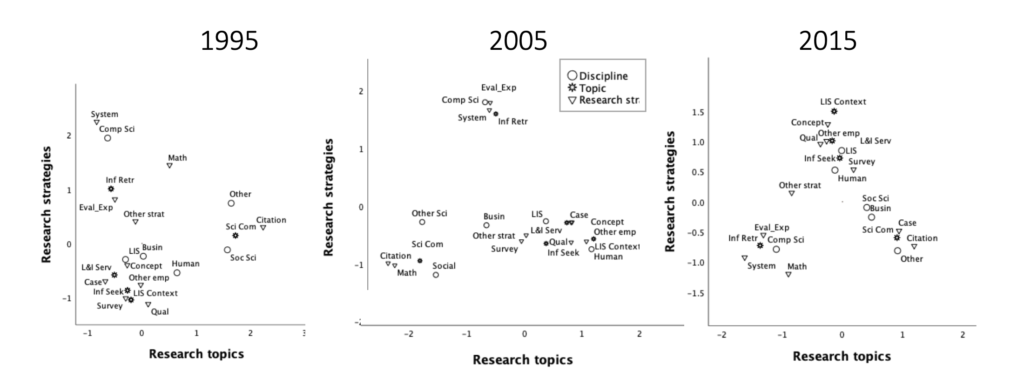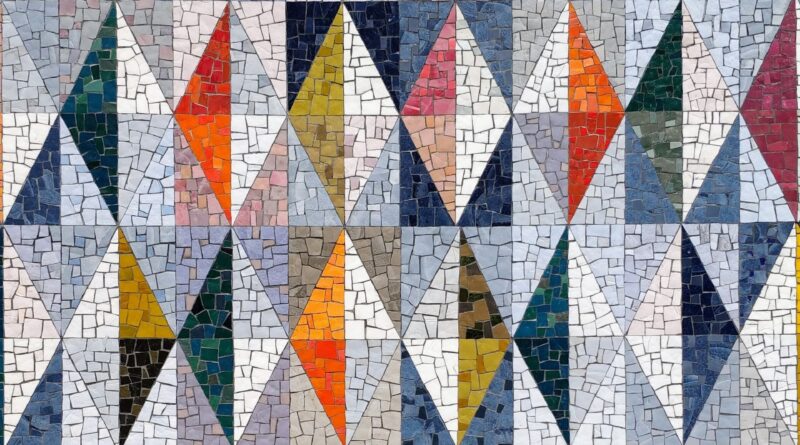Information Science Breaking up?
Information Science: Breaking Up?
Pertti Vakkari, Tampere University
Kal Jarvelin, Tampere University
Yu-Wei Chang, National Taiwan University
Well, one may question how solid it has been so far. Many would nevertheless agree that the institutional library/information service R&D, information seeking, information retrieval, and biblio/infor/scientometrics form the landscape of Library and Information Science (LIS). These subareas are also brought forward in introductions to, and analyses of LIS (e.g., curricula, lectures, textbooks). Still, scholars contributing to different subareas may increasingly turn their attention toward the territory outside LIS – and be integrated there – or remain as visitors to LIS, being based outside. Are there indications toward that in LIS research? We decided to analyze the trends.
—The current trends point toward fragmentation of LIS as a discipline.—
We made a long-term analysis of research topics and methods imLIS. Its focus is on how the researchers’ disciplines affect the development of LIS. For our analysis we collected articles published in 31 scholarly LIS journals at ten-year intervals – in 1995, 2005, and 2015. The set of journals varied slightly between the years due to closing of some journals and popping-up of new ones. Our interest was not the analysis of journals but rather the published articles. Therefore we did our best to harvest articles representing research in LIS and excluding other articles such as editorials, columns, and articles beyond LIS. In the analysis we classified the topic and method of each article, as well as the discipline of each author. An article was considered as a joint contribution of each unique discipline of the authors. We managed to do this well enough for statistical analysis as witnessed by a reliability test (Kappa). The dataset is unique – collected in a coordinated way and spanning two decades. It consists of data for about 2500 articles and nearly 3000 instances of contributing disciplines. It allows trend analysis.

The first things we found were the shrinking trend in the share of LIS contributions from 67% to 36% even if their number grew in 20 years’ time. This happened because the number of contributions especially by Computer Science and Economics authors grew much faster than the number of LIS-internal contributions. Their shares grew from 9% and 6% to 21% and 16%, respectively, in the same period. In all, the early dominant role of LIS scholars in knowledge production in all LIS research topics has declined– most dramatically in information retrieval (-43% units), but also in all other research topics (-14 to -24% units). LIS scholars were in 2015 still major contributors in LIS context and L&I services with a share of about 2/3, while in information retrieval their contribution share was only 1/5, bypassed by computer scientists with their share of about 50%. In information seeking the contribution share of LIS was in 2015 still the largest one, but in scientific communication both Economics and other sciences (Engineering, Natural sciences, and Medicine) caught up LIS.
For our second set of findings, we used correspondence analysis to tell, which LIS research topics, methods, and contributing disciplines tend to go hand in hand in LIS research. We identified three clusters of topics, methods, and disciplines that evolved over the time studied:
- Cluster I is closest to library and information (L&I) practice and involves topics about LIS context (profession, education, institutions, and history), L&I services and information seeking which use survey, qualitative, case study, and conceptual research methods – reflecting the variety of approaches in these topics. LIS itself, and Humanities and Economics are the closest contributing partners after Economics sliding away after the initial years.
- Cluster II focusses on scientific communication with citation analytic research methods and Social sciences and other sciences (Engineering, Medicine and Natural sciences) in its collaboration neighborhood – echoing the application of scientometrics in many disciplines for research evaluation. The great activity in developing bibliometric indices shows in collaboration with Math around 2005
- Cluster III deals with the topic information retrieval which is close to evaluation and experiments, and system analytic research methods. It collaborates after an unfocused initial collaboration landscape, with Computer science and Mathematics – a realistic view on mainstream IR research applying data mining and machine learning methods.
 Overall, it seems that within the observed 20 years research clusters in LIS have differentiated somewhat. Clusters II and III around scientific communication and information retrieval have tighter associations among their disciplines and research methods. In addition, the professionally oriented LIS Cluster I has differentiated internally to some extent between LIS context, L&I services and information seeking.
Overall, it seems that within the observed 20 years research clusters in LIS have differentiated somewhat. Clusters II and III around scientific communication and information retrieval have tighter associations among their disciplines and research methods. In addition, the professionally oriented LIS Cluster I has differentiated internally to some extent between LIS context, L&I services and information seeking.
The trends in authors’ disciplines and the development of the three topical clusters of LIS research, focusing on different topical subfields, methodologies and contributing disciplines may have great consequences. Gaining significant shares, if not major roles, in various LIS research topics, the contributing disciplines infuse their concepts, research questions and approaches to LIS and may also subsume vital parts of LIS in their own structures of knowledge production. The restructuring of information, media and commercial practices around the Web will likely cause a corresponding restructuring of the related research fields. In the cracking and frictions which are unavoidable in the pursuit of a new constellation – both cognitive and social – LIS is too small a player to determine the result. The current trends point toward fragmentation of LIS as a discipline.
This Information Matters article is a translation of “The Association of Disciplinary Background with the Evolution of Topics and Methods in LIS Research 1995-2015” by Pertti Vakkari, Kal Jarvelin, and Yu-Wei Chang. https://doi.org/10.1002/asi.24757
Cite this article in APA as: Vakkari, P., Jarvelin, K., & Chang, Y. (2023, April 19). Information science: Breaking up?. Information Matters, Vol. 3, Issue 4. https://informationmatters.org/2023/04/information-science-breaking-up/





